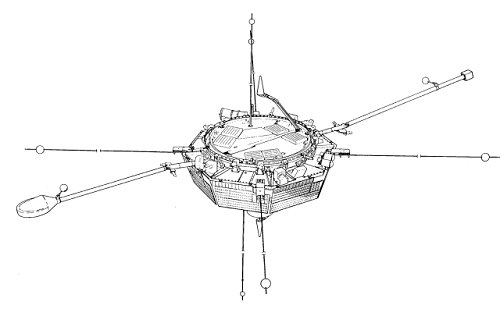
Viking's perigee boost motor placed this relatively small satellite (286 kg) into a final 817 km - 13,530 km polar orbit, where it conducted scientific observations of complex plasma processes in the magnetosphere and ionosphere of the earth. The satellite carries experiments to measure electric fields, magnetic fields, charged particles, waves, and auroral images. These experiments were supplied by scientific teams from Sweden, Canada, Denmark, France, Norway, the United States, and the Federal Republic of Germany.
Project origins
In recognition of the growing market for satellite services and the desirability of promoting Swedish industry's capabilities in this field the Swedish space budget was increased considerably in the early 1980's. Given Sweden's long traditions in magnetospheric and ionospheric research it was only natural that the first national satellite should carry an advanced magnetospheric research payload into regions of space believed to hold many secrets of this scientific discipline. Thus VIKING's mission was twofold:- to be an industrial policy tool helping Swedish industry expand its capabilities in the space technology area
- to perform a qualified "scientific first" space exploration.
VIKING Satellite Summary
| International Designator
Catalogue number |
1986-19 B
16614 |
| Launch | February 22. 1986 at 0144:35 UT
from Kourou.
Ariane V 16 together with the SPOT 1 satellite |
| Mass | Lift-off mass 520 kg. dry mass 286 kg 60 kg science payload |
| Initial Orbit | 814-13530 km. 98.6o inclination. 261.2 min period |
| System life |
|
| Size | Octagonal disk 0.5 meter high. 1.9 meter in diameter. |
| Booms | The satellite carried four 40 meter
long radial wire booms and two 4 meter long axial booms.
These booms supported V1 and V4. In addition there were two short stiff radial booms for the V2 and V4 sensors. |
| Power |
|
| Attitude | Quarter-orbit magnetic torqueing
of the 3 rpm cartwheel spin vector.
Magnetometer-commutated spin coil for spin rate control. |
| Telemetry | 2.5 Watts RF power on 2208.163 MHz at 54.6 kbps (49.6 kbps of science data) |
| Telecommand | S-band uplink on 2033.5 MHz |
| Tracking & Cntrl | ESRANGE. Kiruna. Sweden (67.89 N.
21.11 E)
Orbital parameters determined from ranging data. |
The Viking Ground Station
The ground station of Viking was located at Esrange, close to the northern border of Sweden. Since the spacecraft carries no tape recorder, observations were acquired only when it was in view of the tracking station. Measurements were made continuously from the time when Viking comes close to the auroral field lines (when it is above the polar region) until the time when it left the auroral field lines on the other side of the pole.Telemetry data from Viking were received and processed on a real time basis at the Esrange tracking station located near Kiruna, Sweden, above the Arctic circle. These data were reduced and displayed by computer graphics techniques immediately after reception at the ground station. Scientists engaged in collaborative analysis of the space plasma phenomena at nearly the instant they are observed. Special "campaigns" were conducted that focus on special scientific topics and co-ordinated observations were made with surface, balloon, rocket and other satellite programs. The Viking program is unique because experiment modes could be changed on a nearly real-time basis in order to concentrate on special phenomena that may be occurring at the moment. Another unique feature of this program is the data distribution system to the international community of scientists. A series of quick look plots (QLP) were produced and distributed on a weekly basis to any scientist in the world for a small charge. These plots contain summaries of the information acquired by all Viking instruments. The goal was to inspire interest in the Viking data from the international scientific community.
Scientific Objectives
Northern Scandinavia is among the most favorable places on earth to measure phenomena related to the coupling of energy between the sun and outer space with the lower atmosphere and ionosphere. This is because the auroral zones are the focal points for this energy deposition, which can reach 1011 watts. The most spectacular manifestation of this phenomena is the northern lights or aurora, which have been studied for centuries by Scandinavian scientists such as Anders Celsius, Kristian Birkeland, Christopher Hansteen, Anders J. Ångström, and Hannes Alfvén.The auroral regions encompass a dynamic
and complex system of plasmas that interact with magnetic fields and electric
currents. The Viking program is directed at understanding large-scale phenomena,
such as plasma convection, global current systems, and auroral morphology,
as well as small scale and microphysical problems, including particle acceleration
processes, wave-particle interactions, shock structure, fine-structured
currents, and auroral kilometric radiation (AKR). Viking was specifically
designed to perform high resolution measurements of electric fields, magnetic
fields, energetic particles, plasma waves, and ultraviolet emissions. The
orbit was chosen to sample the auroral plasmas at intermediate altitudes
(1-2 RE) that are not usually explored by satellites and where a wealth
of interesting processes is predicted to occur, including the key mechanisms
responsible for the acceleration of auroral particles. The Viking spacecraft
and its complement of instruments are described here.
VIKING Experiment Summary
VIKING carried into space a comprehensive selection of instruments put together by Swedish scientists in collaboration with colleagues from abroad and grouped into five main experiments. The experiments are mounted on a payload deck with sensor units on the upper side and electronics units on the lower side getting radiation protection from the deck. Some of the sensors are mounted on extendible booms to provide better measurement resolution or to get away from the disturbing influence of the satellite itself. The main experiments are:Vl The electric field experiment
This experiment used three orthogonal
pairs of sensor spheres mounted on four 40 m radial wire booms and two
4 m stiff axial booms to measure the three components of the electric field.
The Royal Institute of Technology in Stockholm was responsible for the
experiment.
V2 The magnetic field experiment
A magnetometer mounted on a 2 m
stiff radial boom made precision measurement of the earth's magnetic field
and was also used in the satellite attitude control system. The magnetometer
was built by the Applied Physics Laboratory at Johns Hopkins University
in USA.
V3 The particle experiment
With the use of several spectrometers
built into seven sensor units this experiment determined the distribution
and energy levels of the charged particles. Kiruna Geophysical Institute
was the main research team.
V4 The wave experiment
Uppsala Ionospheric Observatory
and the Danish Space Research Institute built this experiment which shed
new light on wave generation and wave/particle interaction in the magnetosphere.
The experiment used a radial stiff boom mounted loop antenna in addition
to the spherical sensors shared with Vl.
V5 UV imaging experiment
The Canadian University of Calgary
supplied two cameras that produced ultraviolet light images of the auroral
zone. In this way the northern light activity could be compared to the
measurements produced by the other experiments.
| Nr | Experiment Name | Principal Investigator | Mass(kg) | Power(W) | Data(kbps) |
| V1 | Electric Fields | Royal Inst. of Technology, Sweden | 3.5 | 7.2 | 4.27 |
| V2 | Magnetic Fields | APL/Johns Hopkins Univ., USA | 2.1 | 2.0 | 2.19 |
| V3 | Particles; Hot Plasma | Swedish Institute of Space Physics, Kiruna | 16.1 | 13.0 | 12.37 |
| V4 | Waves | Swedish Institute of Space Physics, Uppsala | 12.1 | 20.5 | 25.60 |
| V5 | Auroral Imager | Univ. of Calgary, Canada | 7.0 | 5.3 | 5.12 |
| Total | 40.8 | 48.0 | 49.55 | ||
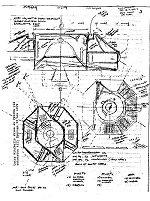 The
Viking Spacecraft
The
Viking Spacecraft
The Viking spacecraft in its deployed
configuration is illustrated in the picture at the top of the page. This
drawing shows the two 2-m-long radial booms used for the magnetic field
and plasma wave experiments. Also shown are the four 40-mlong wire booms
and two 4-m-long axial booms used for the electric field experiment. The
flux gate magnetic field sensor is located at the end of the thick boom
pointing up, and the search coil magnetometer sensor is located at the
end of the thick boom pointing down. The "whisk-shaped" plasma wave antennas
are located near the end of each rigid boom. The satellite's spin axis
is perpendicular to the two rigid booms and is approximately horizontal
in the cover drawing. The particle detectors and UV imager cameras are
located with the solar panels along the many-sided outside edge of the
satellite, and their fields of view are directed radially away. In its
stowed launch configuration, Viking was about 0.5 m high and 2 m in diameter;
it weighed 520 kg at lift-off, including 262 kg for the perigee boost motor.
In orbit its final mass was 286 kg. Power was supplied by eight body-fixed
solar arrays, with a battery providing backup power during eclipses. Telemetry
was provided by an S band link at a 55-kbit/s data rate. Data were received
on a real-time basis at the Esrange ground station. A spin rate of 3 rpm
was maintained by magnetic coil torquers commanded from the ground. VIKING
was a single string system without redundancy.
Project Schedule
The Viking project was started in January 1978 with discussions with the Intercosmos council of the Academy of Sciences of the Soviet Union about a joint magnetospheric satellite project, named M-SAT. In March 1978 a preliminary technical proposal was submitted to the Intercosmos council. In November 1978 first contacts were taken with Boeing Aerospace about using their technology from the S-3 (Small Secondary Satellite, a series of scientific satellites launched piggyback on classified payloads) program and the Applications Explorer Missions.In 1979 a feasibility study of M-SAT was conducted by SAAB and Boeing and SSC first considered the use of an Ariane piggyback launch. In September 1979 the use of a Soviet rocket was abandoned, and Ariane was chosen as the launch vehicle. A project definition study was run until June 1980 and on 21 August 1980 the Swedish Cabinet approved the project. The development contract with SAAB was signed on September 1, 1980.
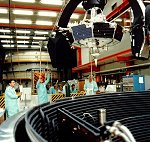 The
preliminary Design Review was held in March 1981 and the Critical Design
Review in October 1981. The satellite platform was delivered by Boeing
to SAAB in December 1982. The solar simulation test at ESTEC was conducted
in July 1983. Because of delays in the launch of the main satellite SPOT
(originally foreseen to occur in March 1984) , Viking was put "in mothballs"
in November 1983.
The
preliminary Design Review was held in March 1981 and the Critical Design
Review in October 1981. The satellite platform was delivered by Boeing
to SAAB in December 1982. The solar simulation test at ESTEC was conducted
in July 1983. Because of delays in the launch of the main satellite SPOT
(originally foreseen to occur in March 1984) , Viking was put "in mothballs"
in November 1983.
In the fall of 1984 some tests (including the magnetic cleanliness test) were performed. In March-April 1985 joint vibration tests with SPOT were conducted in Toulouse. Viking was shipped to Toulouse for launch in September 1985, but the launch was delayed again because of the failure of Ariane V15 (Friday 13 September). Viking arrived in Kourou in October 1985 and staff from SSC arrived at the launch site on 11 November 1985.
Further last minute launch delays occured and Viking and SPOT were finally launched into orbit on February 22, 1986 - eight years after the first project idea was discussed.
Launching Arrangement
The Ariane 1 rocket was a three stage liquid fuel rocket with a lift-off mass of 235 tons and a lift-off thrust is 2649 kN. The rocket was 50 meters long and has a diameter of 3.35 meters. The fist two stages were propelled by N2O4 and UDMH. The third stage used liquid oxygen and liquid hydrogen.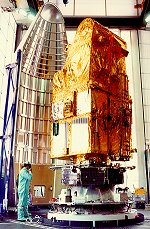 For
launching Viking on the Ariane 1 rocket a special arrangement was made.
Viking was mounted on the payload adapter of the Ariane rocket. The mechanical
interface of Ariane was duplicated on top of Viking. The French SPOT satellite
was the mounted on this interface. Thus, Viking was "transparent" with
regard to the launch vehicle interface. Upon reaching orbit, SPOT was released
first while the third was under three axes control. After a maneuver to
put the separation vector parallel to the orbital tangent at the orbital
apexes, the third stage was spun up to 10 rpm and Viking was separated
by releasing a clamp-band.. Four seconds after separation solid propellant
spin rockets fired to give Viking a 50 rpm spin in preparation for ignition
of the orbit adjust motor.
For
launching Viking on the Ariane 1 rocket a special arrangement was made.
Viking was mounted on the payload adapter of the Ariane rocket. The mechanical
interface of Ariane was duplicated on top of Viking. The French SPOT satellite
was the mounted on this interface. Thus, Viking was "transparent" with
regard to the launch vehicle interface. Upon reaching orbit, SPOT was released
first while the third was under three axes control. After a maneuver to
put the separation vector parallel to the orbital tangent at the orbital
apexes, the third stage was spun up to 10 rpm and Viking was separated
by releasing a clamp-band.. Four seconds after separation solid propellant
spin rockets fired to give Viking a 50 rpm spin in preparation for ignition
of the orbit adjust motor.
After the launch from Kourou at 0144:35 UT on February 22, 1986, Viking was put into a 822 km circular parking orbit at 98.7o inclination. This orbit was raised to reach scientifically interesting regions. On the second orbit around the earth, at 0505:01 UT when Viking was at at a point in space near Easter island, a Thiokol STAR 26 C motor fired for 17 seconds. This maneuver raised the apogee of the orbit to 13530 km.. The satellite will decay in 100,000 years.
Mission Operations
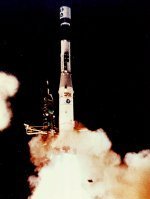 VIKING
was operated by a crew of four people from a control room at the "radar
hill" at Esrange. During the design life of eight months mission operations
were nominal, but in October 1986, a short occurred in one of the electrical
shunts used to dump excess solar panel power. This short took 1.5 A from
the satellite's main bus and reduced the amount of power available to charge
the battery. The harsh radiation environment in VIKING's orbit degraded
the solar panels, and on 12 May 1987, it was not possible to keep the battery
charged any longer and contact was lost with VIKING.
VIKING
was operated by a crew of four people from a control room at the "radar
hill" at Esrange. During the design life of eight months mission operations
were nominal, but in October 1986, a short occurred in one of the electrical
shunts used to dump excess solar panel power. This short took 1.5 A from
the satellite's main bus and reduced the amount of power available to charge
the battery. The harsh radiation environment in VIKING's orbit degraded
the solar panels, and on 12 May 1987, it was not possible to keep the battery
charged any longer and contact was lost with VIKING.
VIKING's flight in orbit yielded a rich harvest of data. Scientific analysis of the telemetry continues more than ten years after the end of the mission. So, VIKING fulfilled all its objectives: It provided first rate science data, it taught Swedish industry the "tricks of the space trade" and it established Sweden as a space-faring nation. What more could you ask?